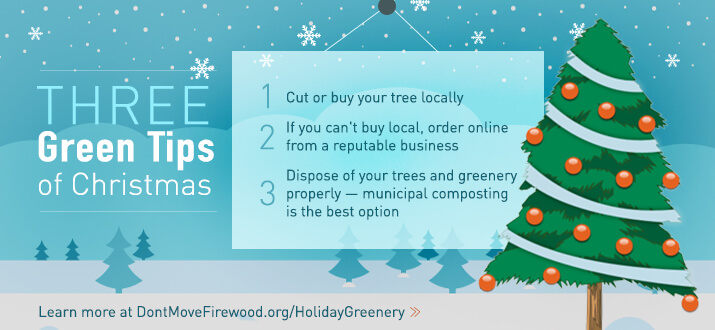Christmas Trees, Wreaths & Decorations May Contain Forest Pests
Cut locally, buy locally, or order online from a reputable business.
Live trees are wonderful, and here at Don’t Move Firewood we think the benefits of buying and enjoying a live ‘real’ Christmas tree are far greater than the risks. But any real forest product might have forest pests, so you’ll want to minimize the chance of introducing a new pest or pathogen into your neighborhood by doing one of these three things:
- Cut your own tree from a forest near your house (with the appropriate permit), or visit a local Christmas Tree farm;
- Buy pre-cut trees and natural wreaths from an established local business, not from a fly-by-night operator selling on the side of the road; and
- When ordering wreaths and garlands online, buy from an established business–not from an unknown person on sites like eBay, Craigslist, or Facebook Marketplace that may not be in compliance with important quarantines or regulations.

Why are real trees better?
- Real Christmas trees are typically grown and harvested in the USA or Canada, supporting local (or regional) farms and small businesses.
- Fake Christmas trees are made with PVC and other materials sourced with fossil fuels, while real trees are made mostly out of sunshine, water, and healthy soils.
- Real Christmas trees sequester carbon as they grow, doing their part to slow the process of climate change.
- Real Christmas trees can be recycled into mulch, artificial fish reef, dune stabilizers, or municipal compost.
See the article “Real vs. Fake – Which Christmas Tree is Better for the Environment” by The Nature Conservancy
Dispose of holiday greenery properly.
Many municipalities accept old Christmas trees to use for mulch, or have a county composting facilities with curbside or depot pickup after the holiday is over. If that is in your area, it is the best option for all your holiday greenery.
If you don’t have a “Christmas Tree Recycling Program” in your area, you are best off disposing of your tree in your area’s solid waste facility (usually a landfill). It might not seem like the best idea, but pests and pathogens can easily escape from materials left in a brush heap or compost pile in your backyard–a risk to your trees that you don’t want to take!
More Resources on Disposing of Trees and Wreathes:
- This Holiday: Decorate with Joy, Not Insects that Destroy, USDA APHIS 2021
- Visit our Disposing of Your Christmas Tree blog, updated in 2020
- Read the National Forest Service blog, Recycling Christmas Trees on National Forest a Seasonal Tradition
The 12 Tree Tips of Christmas
- Get a real tree, not an artificial one. Real trees are better for the environment, better for the economy, and smell wonderful.
- Cut your own tree from a nearby National forest or state land, if possible. Permits are usually inexpensive, and it can be a fun family tradition.
- Get two permits or buy two trees, and donate your extra tree to a local charity, youth home, or non-profit. Make sure to call ahead to find out if they can use it, and what height tree they’d need.
- When buying a real tree from a vendor, make sure they are reputable local dealers. Fly-by-night operators are less likely to comply with state or federal regulations.
- Real trees should be healthy- a good tree will have perky bright green needles and springy soft branches.
- Live trees will travel best if gently wrapped in a reusable tarp or placed in a large burlap bag. Make sure to tie the tree to your vehicle firmly to prevent broken branches.
- Christmas trees with root balls rarely survive being transplanted in the dead of winter. Stick with a cut, local, tree for your holiday display- and use the money you save to buy a healthier sapling in springtime!
- Make homemade and inexpensive garlands, wreaths, and table arrangements from Christmas tree cuttings and other local materials. Re-use!
- When creating homemade decorations, take care not to use invasive species like Asian bittersweet or Multiflora rose.
- A simple bowl of pine cones can make a free and gorgeous, centerpiece. Collect your cones locally and intersperse a few dry cinnamon sticks to make a fresh, aromatic display.
- Dispose of small holiday greenery at a municipal compost facility, or in your regular trash. Don’t throw them out in a brush pile or your home compost– they could contain weed seeds or foreign bugs that can infest the trees around your house.
- Recycle your Christmas tree whenever possible. Many areas now offer a post-Christmas curbside pickup, and the trees are typically chipped or ground to use in mulch. Look for information specific to your area in your local newspaper.
See also the TNC article: “Holiday Tips: Don’t Spread Forest Pests With Your Christmas Tree“
Full List of Resources on Holiday Greenery:
- Real vs. Fake – Which Christmas Tree is Better For the Environment? – The Nature Conservancy
- Holiday Tips: Don’t Spread Forest Pests With Your Christmas Tree – The Nature Conservancy
- Five Ways Recycled Christmas Trees Can Live on After the Holidays, fun and engaging information on the benefits of real trees from Arbor Day Foundation
- This Holiday: Decorate with Joy, Not Insects that Destroy, USDA APHIS 2021
- Don’t Move Firewood sample press release on Holiday Greenery
- Disposing of Your Christmas Tree, a Don’t Move Firewood blog



